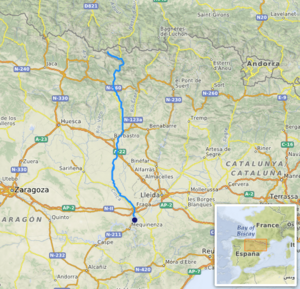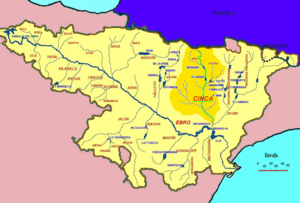Cinca (Spain) facts for kids
Quick facts for kids Cinca |
|
|---|---|

Cinca river at Aínsa
|
|
 |
|
| Country | Spain |
| Physical characteristics | |
| Main source | 2,500 m (8,200 ft) |
| River mouth | Segre River |
| Length | 170 km (110 mi) |
| Basin features | |
| Progression | Segre→ Ebro→ Mediterranean Sea |
The Cinca is an important river in Aragon, Spain. It starts high up in the Pyrenees mountains, specifically in the Circo de Pineta, which is part of the beautiful Ordesa y Monte Perdido National Park. The Cinca flows for about 170 kilometers (106 miles) before it joins another river called the Segre River. This meeting point is near La Granja d'Escarp. Not far from there, the Segre River then flows into the much larger Ebro River. The Cinca River is very important for the farms in the area because it brings water to a rich agricultural region.
Contents
Where the Cinca River Flows
The Cinca River begins its journey in the Pineta area. It starts as many small streams and waterfalls, rushing down from the Tres Sorores mountains. The river flows through the entire Pineta valley, collecting more water as it goes.
Rivers Joining the Cinca
As the Cinca continues its path, other rivers and streams join it. Near the town of Bielsa, the Barrosa River adds its waters. A little further on, the Cinqueta River also joins.
When the Cinca reaches Aínsa, a significant river called the Ara River flows into it from the right side. This is also where you find the Mediano Reservoir, a large lake created by a dam.
Right after the Mediano Reservoir, the Cinca passes through a narrow gorge called Entremón. It is then dammed again, forming the El Grado Reservoir near the town of El Grado. Soon after this, the Ésera River joins the Cinca from the left. The Ésera is the Cinca's most important tributary, meaning it's the biggest river that flows into it.
More Tributaries and the End of the Journey
Further downstream, the Vero River joins the Cinca from the right side. When the Cinca reaches the town of Monzón, the Sosa River flows into it from the left. Later, the Alcanadre River also joins from the right.
Finally, near the town of Massalcoreig, the Cinca River meets the Segre River. Together, these waters then flow into the mighty Ebro River, completing the Cinca's long journey.
History of the Cinca Valley
People have lived along the middle parts of the Cinca River for a very long time. While the upper parts of the river were mostly wild, the lower valley has been home to humans for centuries.
Ancient Times and Name Changes
During the first Iron Age, ancient groups of people, known as migratory villages, used the Cinca Valley as a path to travel inland. The Ilergetes were one of the groups who lived in this area.
The name "Cinca" comes from the ancient Roman name "Cinga." The famous Roman leader Julius Caesar used this name when he wrote about the civil war. Later, when the Moors were in Spain, the river's name changed to Az-Zaytum. This name meant "the River of Olives," showing how important olive trees were in the region.
See also
 In Spanish: Río Cinca para niños
In Spanish: Río Cinca para niños
- Cinca Medio
- Baix Cinca
- List of rivers of Spain


